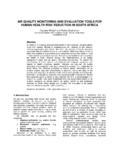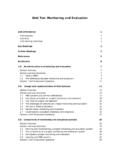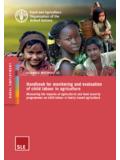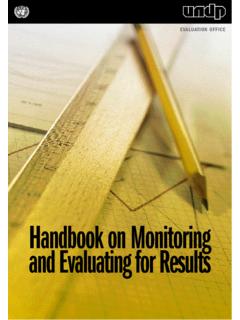Transcription of Table of Contents - UNICEF
1 1 Table of Contents : monitoring and evaluating advocacy ..1 Distinctive features of advocacy monitoring and evaluation ..2 Five questions for planning advocacy monitoring and evaluation ..4M&E Question 1. Who are the monitoring and evaluation users? ..5M&E Question 2. How will monitoring and evaluation be used? ..5M&E Question 3. What evaluation design should be used? ..6M&E Question 4. What should be measured? ..13M&E Question 5: What data collection tools should be used? ..20 Putting it all together: Case studies from Tanzania, Mexico, Tajikistan and Iceland ..47 Following up with next steps ..39 Overall Guidance and Direction Kseniya Temnenko, Samuel BickelAuthor Julia Coffman, Director, Center for evaluation InnovationContribution, Input and Review UNICEF staff, with particular thanks to Dennis Arends, Marta Arias, Christina Bierring, Sophie Busi, Paula Claycomb, Robert Carr, Samantha Cocco-Klein, Janie Eriksen, Roumiana Gantcheva, Joaquin Gonzalez-Aleman, Rafael Hermoso, Bastiaan Van t Hoff, Dina Husary, Melva Johnson, Robert McCouch, Pierre Ngom, Finbar O Brien, Muhammad Akram Rana, Harold Randall, Nicholas Rees, German Reyes, Alexandra Roth, Kobehi Guillaume Toutou, Mayada WahshGabrielle Watson, Oxfam AmericaAcknowledgmentsThis has been a joint project of the evaluation Office, the Division of Policy and Practice, the Private Fundraising and Partnerships Division, and the Regional Offices, in particular the Regional evaluation Advisors.
2 This Companion would not have been possible without rich contributions from across the organization gathered though the Global M&E Community of Practice, which consists of over 350 UNICEF colleagues from over 70 countries. Editing: Catherine RutgersDesign: Cynthia SpenceAcronymsCRC Convention on the Rights of the ChildECCO Episodic Communication Channels in OrganizationsM&E monitoring and evaluationMIS Management Information SystemNGO non-governmental organizationPDNA Post-Disaster Needs AssessmentPCNA Post-Conflict Needs AssessmentRTE Real-time evaluationSMART specific, measurable, achievable, results-oriented, time-boundUN United NationsUNICEF United Nations Children s FundUNHCR United Nations High Commission for Refugees WFP World Food ProgrammeMonitoring and Evaluating Advocacy: Advocacy Toolkit companion1 monitoring and evaluation can shape and transform an advocacy strategy and help ensure results have the maximum effect.
3 This document outlines basic steps in planning monitoring and evaluation for advocacy and covers: Distinctive features of monitoring and evaluation for advocacy. Five questions for planning advocacy monitoring and evaluation . Special Focuses on equity, humanitarian advocacy monitoring and evaluation , and knowledge management. Seventeen data collection tools for measuring advocacy outputs, outcomes and impacts. Four Case Studies from Kenya, Nigeria, Tanzania, Mexico, Tajikistan and Iceland. Following up with next is the full version of Chapter 4 in UNICEF s Advocacy and Evaluating Advocacy When reading through this document and the Advocacy Toolkit as a whole, it is important to keep in mind the difference between monitoring and evalu-ation. According to UNICEF s Programme Policy and Procedure Manual: monitoring measures progress in achieving specific results in relation to a strategy s implementation plan.
4 evaluation attempts to determine as systematically and objectively as possible a strategy s worth or significance. The toolkit refers to two types of evaluation : (1) impact evaluation , which measures a strategy s results for people and communities, and (2) formative evaluation , which measures a strategy s quality and efficiency, examining what was done and how well it was done. For advocacy, performance monitoring and formative evaluation are more prevalent than impact evaluation ; consequently, many of the M&E ideas presented in this chapter are useful for those evaluation is less common because most advo-cacy evaluation focuses on whether advocacy strategies achieved their goals changing a system, increasing funding for a policy or programme, changing a policy rather than extending to impacts such as whether children and women are better off as a result of an advocacy effort.
5 But impact evaluation is an important tool. More attention monitoring AND EVALUATING ADVOCACYKeep in mind Since advocacy is often a long-term effort involving many actors, it requires an M&E approach that recognizes the unique, collaborative and complex nature of advocacy work. Advocacy occurs in a dynamic and fast-changing environment, which requires flexibility and at the same time makes monitoring and evaluation all the more from: Global Capacity Building Workshop on Community and Child Centred Advocacy, Building Capacity in Advocacy to End Violence against Children , Save the Children, 2006.!!**32is needed on monitoring and evaluating what happens after an advocacy goal is achieved, focusing on the implementation and sustainability of that goal and its benefits for children and get the most out of assessment, advocacy monitoring and evaluation can and should be used for purposes of strategic learning using monitoring to help orga-nizations learn in real time and adapt their strategies to changing circumstances.
6 It means integrating evaluation and evaluative thinking into strategic decision-making and bringing timely data to the Table for reflection and action. It means embedding evaluation within the advocacy effort so that it influences the Positioned in this way, monitoring and evaluation can be decisive to the success of an advocacy strategy. Distinctive features of advocacy monitoring and evaluationPlanning for evaluation should occur at the start of an advocacy effort, ideally while the strategy is being developed or soon after. This is based on the proven premise that evaluation can be a key resource when integrated into advocacy efforts because it supports and informs the work as it evolves. Among elements that distinguish monitoring and evaluation (M&E) for advocacy:Time frames can be unpredictable. Achieving an advocacy effort s goals, particularly for policy advocacy, often takes many years.
7 M&E data are often required before goals are achieved. Strategies and milestones shift. Advocacy strategy evolves over time, and activities and desired outcomes can shift quickly. For M&E it means making adjustments so it is more relevant and realistic within an advocacy of contribution is expected, not attribution. When the purpose of evaluating advocacy is to determine impact, attribution is not possible. Therefore, evaluations that examine the link between advocacy efforts and their results have adopted a standard of contribution over progress is important, not just impact. Advocacy M&E typically focuses on the advocacy journey rather than just the destination. In addition to demonstrating progress, this approach reduces the risk that the evaluation will conclude that the whole advocacy effort was a failure if advocacy goals are not achieved within the evaluation s time should always be considered.
8 Context matters when choosing advo-cacy strategies. It also matters when choosing M&E approaches and interpreting evaluation Coffman, Julia, et al., evaluation for Strategic Learning: Principles, practice, and tools , Center for evaluation Innovation and Innovation Network, Washington, DC (forthcoming); and Healy, John A., What is Strategic Learning and How Do You Develop an Organizational Culture that Encourages It? The evaluation Exchange, vol. 11, no. 2, p. 8. Keep in mind UNICEF advocacy is human-rights based and adheres to interconnected values recognizing the universality of human rights, honouring diversity, ensuring resources are distributed equitably, and making sure that the people who are affected by an issue are represented during decision-making and are able to advocate on their own behalf. UNICEF advocacy is necessarily evaluated according to the extent that it advances rights-based values.
9 This approach, called values-based evaluation , means judging how well values are integrated into practice, as well as using values to shape how evaluations are conducted.!!** monitoring and Evaluating Advocacy: Advocacy Toolkit companion3An equity focus in the monitoring and evaluation (M&E) of advocacy efforts must address several issues. The most important are the following: 1. Examine equity evidence when developing the advocacy positionsWhen a literature review reveals that the evidence base is lacking, new work may be needed before an advocacy position can be confidently developed. Pilot projects are a recommended solution. These can be explic-itly designed to attain or to measure equity effects. Managing good pilot projects requires good M&E inputs. Consult the UNICEF guid-ance on pilot programming at Section 18 of Chapter 6 at PPP Manual.
10 For more general guidance on generating evidence for advo-cacy, see Section Question 1. 2. Model equity outcomes during advocacy planning Prospective research on equity at the plan-ning stage helps to identify determinants of inequality and the effects of the desired policy change. Once there is agreement on what the likely outcomes are and how they serve equity objectives, the advocacy campaign has a powerful communications tool. Modeling normally requires skilled support and a robust data base to use for inputs. Fortunately, many assumptions can be tested and hypothetical data sets can be employed in many Advocate for employing equity-focused M&E methods to gather evidence when policies shift. Special Research Techniques: Special data gathering and analysis techniques may be needed to understand the conditions of extremely disadvantaged, hidden, and marginal populations that often are not reliably reached via standard research and sampling techniques.
















